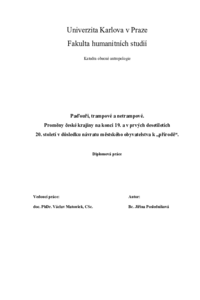Paďouři, trampové a netrampové: proměny české krajiny na konci 19. a v prvních desetiletích 20. století v důsledku návratu městského obyvatelstva k "přírodě"
Tramps, Townees, Sportsmen Transformation of Landscape in Bohemia in the end of 19th Century and First Decades of 20th Century in Consequence of Return of Urban Population to Nature
diplomová práce (OBHÁJENO)

Zobrazit/
Trvalý odkaz
http://hdl.handle.net/20.500.11956/30074Identifikátory
SIS: 60504
Kolekce
- Kvalifikační práce [6555]
Autor
Vedoucí práce
Oponent práce
Lenderová, Milena
Fakulta / součást
Fakulta humanitních studií
Obor
Obecná antropologie - integrální studium člověka
Katedra / ústav / klinika
Katedra obecné antropologie
Datum obhajoby
16. 3. 2010
Nakladatel
Univerzita Karlova, Fakulta humanitních studiíJazyk
Čeština
Známka
Výborně
Práce pojednává o proměnách české krajiny na konci 19. a v prvých desetiletích 20. století v důsledku návratu městského obyvatelstva k přírodě. Nejdříve se zabývá fenoménem návratu k přírodě a dále faktory, které se k němu pojí, tj. industrializace, průmysl, romantismus a volný čas. Tyto faktory nevedly pouze ke vzniku fenoménu návratu samotného, ale i fenoménů dalších, tj. ochrana přírody, rozmach sportovních činností. Jedním z ústředních motivů této diplomové práce byl předpoklad, že lidé uzavření do městských aglomerací záhy touží po alespoň chvilkovém, ale pravidelném úniku z rušného prostředí. Formovalo se tak hnutí "návratu k přírodě". Narůstající obliba rekreačních aktivit vedla k výraznějšímu zásahu do charakteru krajiny; rekreační aktivity byly také jedním z prostředků šíření městské civilizace na venkov. Práce mapuje vznik a vývoj základních volnočasových aktivit (turistika, tramping, sport) a také jejich projevů (budování rozhleden, víkendových osad). Modelovou oblastí je prostor Senohrab a Hrusic, od konce 19. století jedna z tradičních rekreačních oblastí obyvatel Prahy.
Precis The thesis discuss a transformation of the landscape in Bohemia in the end of 19th century and first decades of 20th century as a consequence of man's return to nature. It primarily deals with various factors that are related to it (Industrialization, Romanticism and leisure time). Not only did these factors give birth to man's return to nature, they also gave birth to the protection of nature and the sports boom. One of the basic theories of this thesis is that people who resided in urban communities became disenchanted with city life and developed a strong desire to escape from the urban environment. This course of events gave birth to the return to nature. The increasing popularity of recreational activities caused the transformation of the landscape; urban civilization also spread to the countryside by the means of recreational activities. The thesis describes the origin and the development of leisure activities (tourism, tramping and sports) and the way they are displayed in the landscape (view-towers, weekend camps). The villages of Senohraby and Hrusice, typical recreational areas since 19th century, are used as examples in order to demonstrate how these events unfolded.
